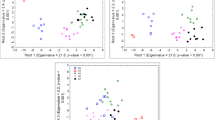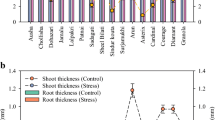Abstract
Forty six soybean (Glycine max [L.] Merr.) varieties were evaluated for their vegetative response to a foliar application of abscisic acid, benzyladenine, or o-methoxyphenyl phosphinic acid (OMPA). Varietal responses to each chemical ranged from no effect to severe growth retardation. When the same varieties were evaluated for their response to water stress, the length of time required for severe wilting ranged from 48 h to 120 h. A cluster analysis was used to relate the coefficient of parentage of the varieties with their response to chemicals or water stress. The response of a variety to one of the chemicals did not predict the response to a different chemical. Further, the response of a variety to a chemical did not predict the response of a similar variety to the same chemical. The water stress rating was neither related to the chemical responses nor to the coefficient of parentage for the varieties in the test. The effects of night interruption and darkness were more pronounced on northern than on southern varieties, analogous with the pattern of reproductive regulation by photoperiod.
Similar content being viewed by others
Abbreviations
- OMPA:
-
o-methoxyphenyl phosphinic acid.
References
DeWilde RC (1971) Practical applications of (2-chloromethyl) phosphonic acid in agricultural production Hort Sci 6:364–370
Dixon WJ (1983) BMDP Statistical software. University of California Berkeley Press, appendix A.37, p 693
Fehr WR, Caviness CE (1977) Stages of soybean development. Special report 80, Cooperative Extension, Iowa State University
Fribourg HA, Johnson IJ (1955) Response of soybean strains to 2,4-D and 2,4,5-T. Agron J 47:171–174
Hymowitz T, Carmer SG, Newell CA (1976) Soybean cultivars released in the United States and Canada: morphological descriptions and responses to selected foliar, stem and root diseases. Internat Ag Pub, INSOY series 9
Jung J, Rademacher W (1983) Plant growth regulatory chemicals: cereal grains. In: Nickell LG (ed) Plant growth regulatory chemicals, volume I. CRC Press, Boca Raton, pp 255–261
Nickell LG (1976) Chemical growth regulation in sugar cane. Outlook on Agriculture 9:57–61
Payne RC, Koszykowski TJ (1977) Differentiation of soybean cultivars by metribuzin sensitivity. J Seed Tech 2:1–10
Sabacky MJ (1978) Herbicidal use of substituted phenyl phosphinic acids. US Patent 4, 130, 410, pp 1–6
Vanderhoef LN, Stahl CA (1975) Separation of two responses to auxin by means of cytokinin inhibition. Proc Natl Acad Sci 72:1822–1825
Wax LM, Bernard RL, Hayes RM (1974) Response of soybean cultivars to bentazon, bromoxynil, chloroxuron and 2,4-DB. Weed Sci 22:35–41
Williams CN, Raghavan V (1966) Effects of light and growth substances on the diurnal leaf movements of Mimosa pudica. JEB 17:742–749
Wright STC, Hiron RWP (1969) (+)-Abscisic acid, the growth inhibitor induced in detached wheat leaves by a period of wilting. Nature (London) 224:719–720
Author information
Authors and Affiliations
Rights and permissions
About this article
Cite this article
Nelson, D.R., Muskopf, Y.M. The validity of using a single soybean variety to evaluate the growth regulatory activity of chemicals. J Plant Growth Regul 5, 49–57 (1986). https://doi.org/10.1007/BF02027386
Received:
Accepted:
Issue Date:
DOI: https://doi.org/10.1007/BF02027386




